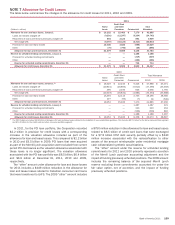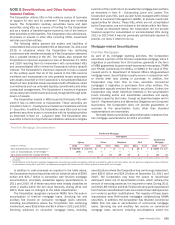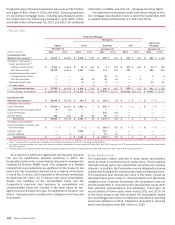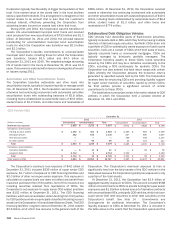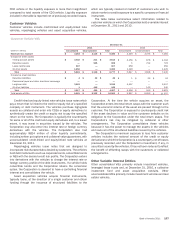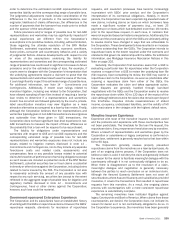Bank of America 2011 Annual Report Download - page 201
Download and view the complete annual report
Please find page 201 of the 2011 Bank of America annual report below. You can navigate through the pages in the report by either clicking on the pages listed below, or by using the keyword search tool below to find specific information within the annual report.Bank of America 2011 199
Other Asset-backed Financing Arrangements
The Corporation transferred pools of securities to certain
independent third parties and provided financing for approximately
75 percent of the purchase price under asset-backed financing
arrangements. At December 31, 2011 and 2010, the
Corporation’s maximum loss exposure under these financing
arrangements was $4.7 billion and $6.5 billion, substantially all
of which was classified as loans on the Corporation’s Consolidated
Balance Sheet. All principal and interest payments have been
received when due in accordance with the contractual terms. These
arrangements are not included in the Other VIEs table because
the purchasers are not VIEs.
NOTE 9 Representations and Warranties
Obligations and Corporate Guarantees
Background
The Corporation securitizes first-lien residential mortgage loans,
generally in the form of MBS guaranteed by the GSEs or by GNMA
in the case of FHA-insured, VA-guaranteed and Rural Housing
Service-guaranteed mortgage loans. In addition, in prior years,
legacy companies and certain subsidiaries sold pools of first-lien
residential mortgage loans and home equity loans as private-label
securitizations (in certain of these securitizations, monolines or
financial guarantee providers insured all or some of the securities),
or in the form of whole loans. In connection with these transactions,
the Corporation or certain subsidiaries or legacy companies make
or have made various representations and warranties. These
representations and warranties, as set forth in the agreements,
related to, among other things, the ownership of the loan, the
validity of the lien securing the loan, the absence of delinquent
taxes or liens against the property securing the loan, the process
used to select the loan for inclusion in a transaction, the loan’s
compliance with any applicable loan criteria, including underwriting
standards, and the loan’s compliance with applicable federal, state
and local laws. Breaches of these representations and warranties
may result in the requirement to repurchase mortgage loans or to
otherwise make whole or provide other remedies to the GSEs, U.S.
Department of Housing and Urban Development (HUD) with
respect to FHA-insured loans, VA, whole-loan buyers, securitization
trusts, monoline insurers or other financial guarantors (collectively,
repurchases). In such cases, the Corporation would be exposed
to any credit loss on the repurchased mortgage loans after
accounting for any mortgage insurance (MI) or mortgage guaranty
payments that it may receive.
Subject to the requirements and limitations of the applicable
sales and securitization agreements, these representations and
warranties can be enforced by the GSEs, HUD, VA, the whole-loan
buyer, the securitization trustee or others as governed by the
applicable agreement or, in certain first-lien and home equity
securitizations where monoline insurers or other financial
guarantee providers have insured all or some of the securities
issued, by the monoline insurer or other financial guarantor. In the
case of loans sold to parties other than the GSEs or GNMA, the
contractual liability to repurchase typically arises only if there is a
breach of the representations and warranties that materially and
adversely affects the interest of the investor, or investors, in the
loan, or of the monoline insurer or other financial guarantor (as
applicable). Contracts with the GSEs do not contain equivalent
language, while GNMA generally limits repurchases to loans that
are not insured or guaranteed as required. The Corporation
believes that the longer a loan performs prior to default, the less
likely it is that an alleged underwriting breach of representations
and warranties had a material impact on the loan’s performance.
Historically, most demands for repurchase have occurred within
the first several years after origination, generally after a loan has
defaulted. However, the time horizon in which repurchase claims
are typically brought has lengthened primarily due to a significant
increase in GSE claims related to loans that had defaulted more
than 18 months prior to the claim and to loans where the borrower
made at least 25 payments.
The Corporation’s credit loss would be reduced by any recourse
it may have to organizations (e.g., correspondents) that, in turn,
had sold such loans to the Corporation based upon its agreements
with these organizations. When a loan is originated by a
correspondent or other third party, the Corporation typically has
the right to seek a recovery of related repurchase losses from that
originator. Many of the correspondent originators of loans in 2004
through 2008 are no longer in business, or are in a weakened
condition, and the Corporation’s ability to recover on valid claims
is therefore impacted, or eliminated accordingly. In the event a
loan is originated and underwritten by a correspondent who obtains
FHA insurance, even if they are no longer in business, any breach
of FHA guidelines is the direct obligation of the correspondent, not
the Corporation. At December 31, 2011, approximately 28 percent
of the outstanding repurchase claims relate to loans purchased
from correspondents or other parties compared to approximately
25 percent at December 31, 2010. During 2011, the Corporation
experienced a decline in recoveries from correspondents and other
parties; however, the actual recovery rate may vary from period to
period based upon the underlying mix of correspondents and other
parties.
The Corporation currently structures its operations to limit the
risk of repurchase and accompanying credit exposure by seeking
to ensure consistent production of mortgages in accordance with
its underwriting procedures and by servicing those mortgages
consistent with its contractual obligations. In addition, certain
securitizations include guarantees written to protect certain
purchasers of the loans from credit losses up to a specified
amount. The fair value of the obligations to be absorbed under the
representations and warranties and guarantees provided is
recorded as an accrued liability when the loans are sold. This
liability for probable losses is updated by accruing a
representations and warranties provision in mortgage banking
income. This is done throughout the life of the loan, as necessary
when additional relevant information becomes available.
The methodology used to estimate the liability for
representations and warranties is a function of the representations
and warranties given and considers a variety of factors, which
include, depending on the counterparty, actual defaults, estimated
future defaults, historical loss experience, estimated home prices,
other economic conditions, estimated probability that a
repurchase claim will be received, including consideration of
whether presentation thresholds will be met, number of payments
made by the borrower prior to default and estimated probability
that a loan will be required to be repurchased. The Corporation
also considers bulk settlements when determining its estimated
liability for representations and warranties. The estimate of the
liability for representations and warranties is based upon currently
available information, significant judgment, and a number of
factors, including those set forth above, that are subject to change.
Changes to any one of these factors could significantly impact the
estimate of the liability and could have a material adverse impact


